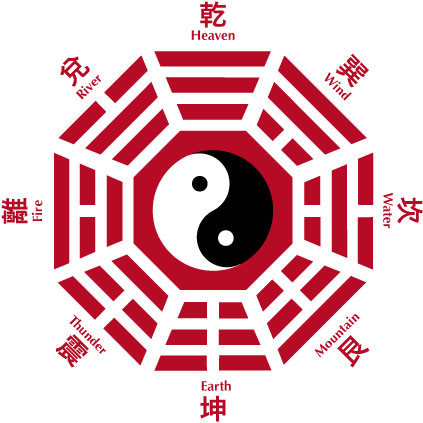Bagua (八卦)
The binary
system was adopted by Ancient Chinese to represent natural
phenomena and philosophic ideas. For example, there are eight trigrams
in
Bagua (八卦; "eight
symbols").
Each trigram consists of three lines, where
each line either "broken" or "unbroken,"
respectively representing yin or yang.
These eight trigrams are:
- 乾 (☰) - sky
- 兌 (☱) - rain
- 離 (☲) - fire
- 震 (☳) - thunder
- 巽 (☴) - wind
- 坎 (☵) - water
- 艮 (☶) - mountain
- 坤 (☷) - earth
| 
|
To divine (卜卦) using the 8 trigrams, a fortune-teller
may toss 3 coins to obtain a trigram.
This is the famous "three-coin
method.
For example, if the first coin is Tail, while the second and the third
coins are heads, you get a "wind" (巽☴) .
If the first and the second coins are tails, while the third is a head,
you get a "mountain" (艮☶) .

In this exercise, we are going to write a program which simulates the
three-coin method.
- The user input the number of iterations he/she wants to conduct.
- In each iteration, the computer simulates the tossing of three
coins, print out the corresponding trigram, and record the occurrence of
each trigram.
- For readability, every five trigrams are separated by a space,
and 50 trigrams by a new line.
- At the end of the simulation,
the program print out the totally occurrence of each trigram.
Your program may run as follows:
Input the number of iterations -- 112
☲☶☷☵☶ ☵☶☷☱☲ ☳☰☵☴☷ ☵☱☵☷☰ ☷☳☳☷☳ ☳☷☷☰☶ ☵☵☴☱☵ ☳☴☱☵☷ ☰☳☷☶☱ ☳☷☲☲☲
☰☶☷☵☰ ☰☵☷☵☴ ☵☰☷☳☱ ☲☷☲☴☶ ☵☰☲☲☷ ☱☷☲☴☴ ☴☵☷☳☶ ☷☶☵☷☷ ☱☶☶☷☲ ☷☲☱☴☲
☱☰☰☳☱ ☳☶☴☱☰ ☴☱
乾(☰) 12
兌(☱) 13
離(☲) 13
震(☳) 12
巽(☴) 11
坎(☵) 16
艮(☶) 12
坤(☷) 23


